In November 2015 a previously unknown photo of the third tallest human known in medical history, John. F. Carroll who stood 8’7.75” (263,5 cm), was published in The Buffalo News magazine. On the discussion board attached to the website thetallestman.com, the publication of the photo led to a debate. Critical voiced was raised against medical data since Carroll seamed to appear much shorter in the photo. In order to solve the debate I came up with a method to test medical data against photographic evidence using 3D applications. The method, that will be described in this article, started with transforming the photo into a real world-scale 3D scene. This was possible since the photograph included objects of known dimensions, in this case a pair of crutches. A 3D human model was then created from recorded medical measurements on Carroll. The model was then incorporated into the 3D scene for comparison and conclusion. My result show that there is no contradiction between medical data and photo evidence in this case.
The lack of photographic evidence

Fig 1. Original caption: “Patient at age 12, 5 feet 6 inches in height”. (Prezio,Griffin & O’Brien, 1961, table 19 Click on image to view larger
John F. Carroll (1932-1969), Buffalo, NY, known in medical litterature as “The Buffalo Giant”, is recognised as the third tallest man in medical history with the height of 8’7.75” (263,5 cm). Carroll’s height was estimated since he suffered from severe kyphoscoliosis – two dimensional curvation of the spine – and was based on what his height would have been if spinal curvation had been normal. His actual standing height was 8’ (243,8 cm).
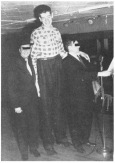
Fig 2. Original caption: Patient at twenty-two years of age, height 7 feet 6 inches. The two gentlemen flanking the patient are both approximately 5 feet 11 inches in height (Prezio et al, 1961, table 2).Click on image to view larger
Contrary to the tallest man ever, Robert Wadlow, 8’11.1.1” (272 cm), of whom there is more than hundreds of photographs to serve as visual testimony, there is to this date only seven photographs of Carroll known widely. Up until 2011, only three photos (Fig. 1-3) of Carroll were officially available through the 1961 medical article on Carroll (Prezio, Griffin & O’Brien, 1961). None of those can be used as visual clues to either strenghten or weaken the 8’7.75”(263,5 cm) claim.

Fig 3. Original caption: “Patient at twenty-seven years of age, 8 feet in height (Prezio et all ., 1961, table 3) Click on image to view larger
Despite deep and serious efforts by members of the online forum attached to the website The Tallest Man (TTM)1 to find more images of Carroll, only three photos has emerged there since the website’s founding in 2009. In january 2011 TTM forum member “warnie” posted a photo (fig.4) of a 17 year old Carroll taken at his junior prom in 1949 (Warnie, 2011). As recognised by TTM forum member “soldierblue” in July 2012, The Buffalo Spree Magazine published a previously unknown photo (fig.5) of Carroll from 1957 in their June issue 2012 showing him lying in a hospital bed with only head, neck, hand and part of his arm and torso visible (Buffalo Spree,2012; Soldierblue, 2012). Finally in August 2015 TTM forum member “ghbearman” posted another facial portrait of Carroll from his 1950 high school yearbook (Ghbearman,2015). Neither of those can be used to support medical data.
Reading through various threads at TTM forum it’s clear that the lack of photos has created a mystical aura around Carroll. Unsurprisingly, sceptical voices have been raised regarding the truth of the medical data. The main arguments has been along the line that even highly trusted official medical data might be inaccurate. Not only due to the obvious risk that even professional doctors can make mistakes and errors, but also to the possibility that medical data might be fabricated for publicity reasons.

Fig 5. Orginal caption: “John Carroll shakes the hand of the man who defeated him in the race for supervisor in 1957, David J. Moran. (Buffalo Spree,2012,p.72). Click on image to view larger
Of course, the absence of photo evidence should not provide any logical reason to doubt medical data. But given the existence of photo evidence that do contradicts medical data it would be unrational to not question the data regardless of the status or reputy of the author.
New photo give rise to scepticism on Carrolls height
On November 7 2015, The Buffalo News (TBN) published a previously unseen photo (Fig 6.) of Carroll. Contrary to the previous known photos of Carroll, this one seemed to be just the kind of photographic evidence that could cast doubts on medical data. The photo was featured in a newsstory about some of Carrolls belongings (most noteworthy a pair of his shoes aswell as his crutches) being exhibited by the Mütter museum in Philadelphia (Warner, 2015).
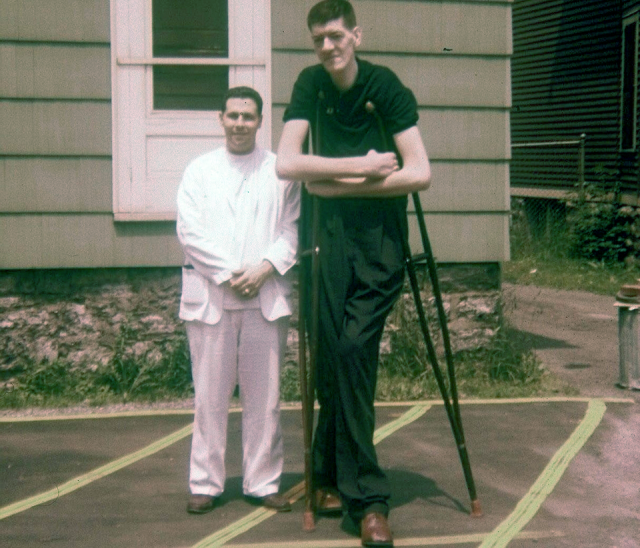
Fig 6. Original caption: “John Francis Carroll, photographed at age 27 in 1960, towers over Dr. Joseph A. Prezio, who remembers Carroll as “a wonderful, happy person, despite all his handicaps.” Prezio said Carroll stood just over 8 feet tall, but an engineer calculated Carroll’s true height at 8 feet, 7.75 inches” (Warner, 2015). Please note that the photo displayed here has undergone a color-correction for a more natural appearence since the original photo (Warner,2015) suffered from “red cast” due to age. Click on image to view larger
The photo (it will be referred to the TBN photo in this article ) was shot in 1960 and shows Carroll standing next to doctor Joseph A. Prezio, one of the authors behind the 1961 medical article (Prezio et al, 1961). The TBN photo has led to an intense debate2 on the TTM forum on whether the photo contradicts the reported height of 8’7.75” (263,5 cm) or not. Clearly the photo is showing a man appearing much shorter than that. This becomes obvious when we compare to photos of Robert Wadlow taken around 1938 (Fig. 7) when he was standing about the very same height according to his growth chart.
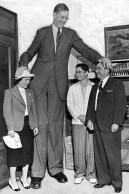
Fig 7. Original caption: “Sep. 13, 1938: Robert Waslow(sic!), world’s tallest man dropped into Los Angeles County Sheriff Eugene Biscailuz’s office for a visit. From left is Jean Mohr, Sheriff’s daughter; Warren Biscailuz, his son, and Sheriff Biscailuz.
The difference in standing height between Carroll and Wadlow is partly explained by the fact that Carroll suffered from kyphoscoliosis which lowered his standing height by 7.75” (19 cm). Furthermore, in the TBN photo Carroll is standing in a very poor posture as he leans over the crutches. But still, given that the crutches is 72” tall members at TTM forum made charts³ to show that Carroll is standing about 7’2.5” (220 cm) – 7’5” (225 cm)in shoes and probably not reaching 8’ (243, cm) in stocking feet even if he stood up straight which leads to the conclusion that the TBN photo contradicts medical data. Others argued that Carrolls posture is indeed so bad in the photo that his total standing height could be 8’ (243,8 cm) – 8’7.75” (263,5 cm) with corrected spine – and thus arguing for the opposite view; the TBN photo supports the medical data.
An attempt to solve the debate
The debate revolves around the issue whether the TBN photo supports or contradicts medical data on Carroll. The main problem here is that the limitations of two-dimensional photography makes it impossible to determine exactly how bad Carrolls’s posture really is in the TBN photo. However, I believe the debate could be solved if we were able to view the photographed scene from different angles. My aim with this study is therefore to provide new insights into the debate by converting the photograph to a three-dimensional scene. The key question for this study is, does the TBN photo contradict medical data on John F. Carroll? To be able to answer the question I will use 3D application techniques to compare Carroll as he appears in the TBN photo with a 3D human model based on medical data on Carroll. This way photographic evidence can be tested against medical evidence.
From 2D to 3D
I will now describe the method I used to convert the TBN photo to a 3D scene of real world scale. For this task I used the 3D application Sketchup Make (version 16.0.19911). In order to be able to transform the photograph to a 3D scene, the position of the camera has to be estimated. With the use o the parrallel lines given by the two houses in the TBN photo we can find out the horisontal line which correspond to the position of the camera. With this information a 3D scene of the street and the two buildings could be created.

Fig 8. A 3D scene of the street and the two houses visible in the photograph is created from the perspective information in the photograph. Note how the 3D scene exceeds the photo. Click on image to view larger
Next, I needed to turn the 3D scene into real-world scale. This was possible thanks to the presence of objects of known dimensions in the photograph (the crutches) that could be used as reference. According to the TBN article the crutches measures 72”. 3D models of the two crutches was made using another (more recently shot) photograph (fig. 9) of the two crutches leaning against a door. The statement that the crutches measures 72” could be put to test by comparing the height of the crutches against the door. I converted the photograph into a 3D scene scaled to give the door a height of 80” which is the most common door height. The crutches in the 3D scene turned out to be 71 29/32” (182,64 cm) assuming an 80” door. This very slight difference of 3/32”(2,4 mm) from the reported height is within the aspected error margin, given the low quality of the photo used to create the 3D scene. The crutches will therefore be assumed to measure exactly 72” (182,9 cm), just as the TBN article states.

Fig 9. Illustration showing the transition from the 2D photograph and to a 3D scene of Carroll’s crutches. Click on image to view larger

Fig 10. A) 3D scene frontview of door isolated. B) 3D scene frontview of door with frame extensions, mat and crutches. C) 3D scene sideview of door with frame extensions, mat and crutches. Click on image to view larger
The 3D models of the two crutches was then imported into the 3D scene of the TBN photo and positioned accordingly (fig 11).

Fig 11. Illustration showing the transition from the TBN photo to a 3D scene where the crutches are positioned accordingly. Click on image to view larger

Fig 12.3D scene set to real-world scale. Each square visible on the ground is 1 square metre. Click on image to view larger
The scene was then set to real-world scale using the crutches height of 72” as reference (fig 12 ).
A 3D human model with Carroll’s dimensions
The next step was to create a 3D model of a man with Carrolls dimensions according to medical data. Using the 3D applications Makehuman (version 1.0.2, 2014) and version 4.74 of Blender (2015), I created a human model based on Carrolls corrected height of 8’7.75”(263,5 cm). In Blender, 3D human models can be posed with the help of ”armatures” which is a set of bones that mimics the human skeleton. Using armatures, the spine of the model was then modified to result in a 7.75” (19 cm) height loss while keeping the total lenght of the spine maintained. The model was also scaled accordingly to the other measurements given by the medical article (Fig. 13).

Fig 13. 3D giant human model scaled after measurements of Carroll. A) Span 102” (259,1 cm). B) Head circumference (occipital to frontal) 26” (66 cm). C) Chest at mammary line 45” (114,3 cm). D) Circumference at umbilicus 40.5” (102,9 cm). E) Circumference at iliac crest 42.5 ” (107,9 cm). F) Circumference at trochanters 43” (108,2 cm). G) Height pubis to heel 51” (129,5 cm). H) Height 96” (243,8cm). Click on image to view larger

Fig 14. Original caption: “Sister Sheila Marie Walsh with the size 16 EEEE boot worn by John Francis Carroll.”(Warner, 2015). Click on image to view larger
I decided to let the model have shoes on since Carroll is wearing shoes in the TBN photo. A recent photo (fig 14 ) of one of Carrolls shoes that was feautured in the TBN article reveals a shoe with relatively high heels, around 2”(5 cm). Eventhough that specific shoe probably is’nt one of the pair of shoes Carroll is wearing in the TBN photo, it’s likely that he wears shoes of a similar type in the TBN photo. So I let the model wear shoes with a 2” (5 cm) high heel.
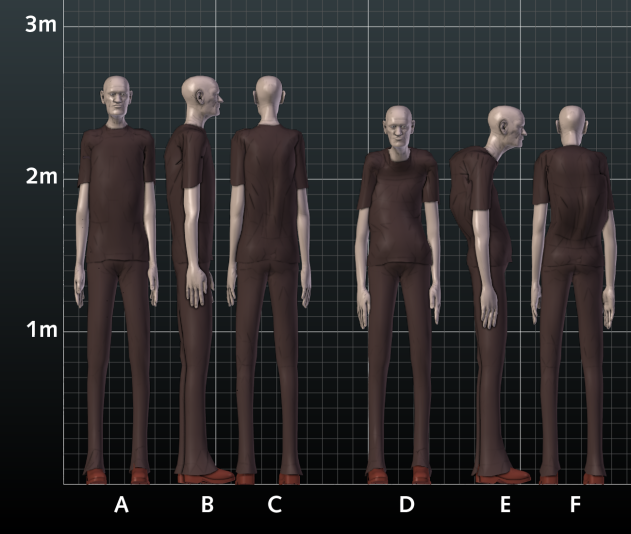
Fig 15. Comparison between 3D human giant model with normal spine curvature at at a height of 8’7.75” (263,5 cm) and with curved spine resulting in a height of 8ft (243,8 cm). Please note that he models are wearing 2″ (5 cm) high shoes that adds to the height. A) Normal spine frontview. B) Normal spine sideview. C) Normal spine rearview. D) Curved spine frontview. E) Curved spine sideview. F) Curved spine rearview. Click on image to view larger
When the 3D human model was done, it was imported into the 3D scene of the street and houses. The model was then posed and positioned according to the photo (fig 16 ). A 3D model of Dr. Prezo was also done using the photograph as reference.

Fig 16. Illustration showing the transition between the TBN photo and final 3D scene. Click on image to view larger
Result
In this study I showed that a 3D human model based on Carrolls medical data could be posed leaning against the crutches as Carroll does in the TBN photograph, resulting in an almost perfect match. The result reveals what kind of posture a 8’ (243,8 cm) tall man need to have, in order to appear as relatively short as Carroll does in the BN photograph (fig 18-20). The 3D human model based on Carroll stands 7’1.25” (216,5 cm) in 2” (5 cm) shoes – 6’11.25” (211,5 cm) in stocking feet – and Dr. Prezio stands 6’0.25”(183,4 cm) in shoes and 5’11.25” (181 cm) in stocking feet assuming 1” (2,5 cm) high heels. Looking at the model in frontview, the degree to which the legs are bent are impossible to distinguish, and the legs seem much shorter than they really are (fig 18). In the TBN photo this is further complicated by the fact that Carroll is wearing rather lumpy clothes.

Fig 18. Frontview showing comparison between 3D human models A) 3D human modeled after Dr. Prezio in the TBN photo. B) 3D giant human based on Carrols measurements posed according to the TBN photo. C) 3D giant human based on Carrols measurements with curved spine. D) 3D giant human based on Carrols measurements with normal spine. Click on image to view larger
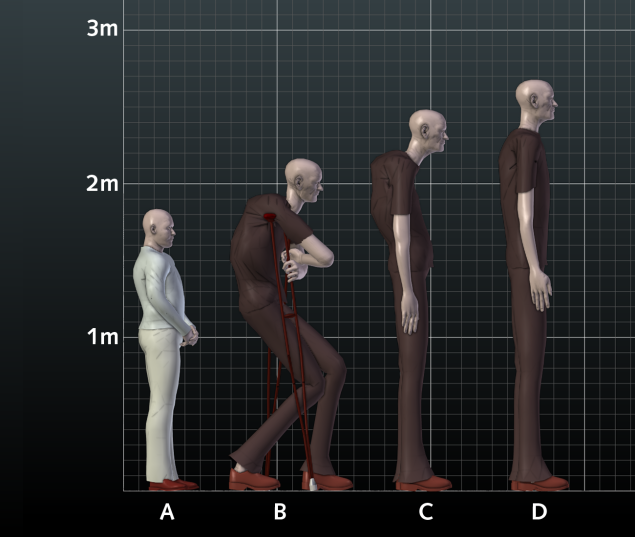
Fig.19. Sideview comparison between 3D human models A) 3D human modeled after Dr. Prezio in the TBN photo. B) 3D giant human based on Carrols measurements posed according to the TBN photo. C) 3D giant human based on Carrols measurements with curved spine. D) 3D giant human based on Carrols measurements with normal spine. Click on image to view larger

Fig 20. Rearview showing comparison between 3D human models A) 3D human modeled after Dr. Prezio in the TBN photo B) 3D giant human based on Carrols measurements posed according to the TBN photo. C) 3D giant human based on Carrols measurements with curved spine. D) 3D giant human based on Carrols measurements with normal spine. Click on image to view larger
Conclusion
According to this study, it is possible for a human of the dimensions given by medical data to appear as relatively short as Carroll does in the TBN photograph. So there is no contradiction between medical data and photographic evidence after all. The key question that this study was trying to answer to was: Does the TBN photograph contradict medical data on John F. Carroll? My results has showed that the answer to this question is no.
Notes
1 See for example discussion forum thread, “John F Carroll newspaper articles”. (2010 May 4) [p.1-5]. Messages posted to http://www.thetallestman.com/whoisthetallest/viewtopic.php?f=4&t=220
2 See discusion forum thread, “More images always welcome?”. [p. 283-287]. Messages posted to http://www.thetallestman.com/whoisthetallest/viewtopic.php?f=4&t=36
³ See discusion forum thread, “More images always welcome?”. [p. 283-287]. Messages posted to http://www.thetallestman.com/whoisthetallest/viewtopic.php?f=4&t=220
References
Blender [Computer software]. (2015). Retrieved from https://www.blender.org/
Buffalo Spree, (2012, June)‘Trivia by town’, Buffaloo Spree, p. 72
[Ghbearman] (2012, July 23). “John F Carroll newspaper articles” [p. 1]. Message posted to http://www.thetallestman.com/whoisthetallest/viewtopic.php?f=4&t=220&p=17581&hilit=Buffalo+Spree#p17581
Makehuman [Computer software]. (2014). Retrieved from http://www.makehuman.org/
Prezio, J., Griffin, J., O’Brien., (1961). Acromegalic gigantism: The Buffalo giant.American Journal of Medicine. 31(6), 966-976.
[Soldierblue] (2015, August 9). “Suggestions for searching certain Giants” [p. 3]. Message posted to http://www.thetallestman.com/whoisthetallest/viewtopic.php?f=4&t=1812&p=23951&hilit=Bishop#p23951
[Warnie] (2011, January 27). “The holy grail of giant hunting?” [p. 3]. Message posted to http://www.thetallestman.com/whoisthetallest/viewtopic.php?f=4&t=513&p=8438&hilit=Prom+1949#p8438
Warren, G. (2015, November 7). John Carroll, ‘the giant of South Buffalo’, will be remembered in Philadelphia Museum. The Buffalo News. Retrieved from http://www.buffalonews.com/city-region/south-buffalo/john-carroll-the-giant-of-south-buffalo-will-be-remembered-in-philadelphia-museum-20151107
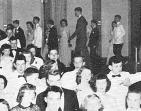
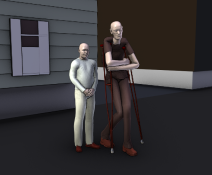
I agree with this estimation…
But I find issue – why crutches are so short, if Carroll was 8 ft 2 In shoe?